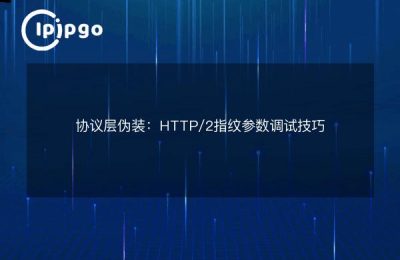
In scenarios such as web crawling, data collection, and privacy protection, the use of IP proxy pools can effectively improve the efficiency and stealth of operations. In this paper, we will detail how to build an IP proxy pool and verify the effectiveness of IP proxies.
What is an IP Proxy Pool?
An IP proxy pool is a collection of multiple IP proxy addresses. By rotating these proxy addresses, a single IP address can be prevented from being blocked or restricted, thus increasing the success and stealth of the operation.
Steps to Build an IP Proxy Pool
The process of building an IP proxy pool can be divided into the following steps:
1. Obtaining an IP proxy
First, you need to get a large number of IP proxies. This can be accomplished in several ways:
- Use free IP proxy sites.
- Purchase a paid IP proxy service: e.g. IPIPGO, etc.
- Build your own IP proxy server: by renting multiple VPS and configuring SOCKS5 or HTTP proxy.
2. Storage IP proxy
After obtaining the IP proxy, it needs to be stored in a data structure for subsequent use. Common storage methods are:
- Text file: stores the IP proxy address line by line.
- Databases: e.g. MySQL, MongoDB, etc. for easy management and querying.
- In-memory data structures: e.g., lists, dictionaries, etc. in Python.
3. Rotation of IP proxies
In order to avoid a single IP address being blocked, IP proxies need to be rotated. Rotation of IP proxies can be accomplished by writing scripts that, for example, randomly select an IP proxy for each request.
Verify the validity of the IP proxy
It is important to verify the validity of each IP proxy before using an IP proxy pool. Below are a few common methods of validation:
1. Connection testing
Check if the IP proxy is able to connect to the target server properly by sending an HTTP request. The following is a Python example:
import requests
def is_proxy_working(proxy)::
try.
response = requests.get('http://www.google.com', proxies={'http': proxy, 'https': proxy}, timeout=5)
if response.status_code == 200: if response.status_code == 200: if response.status_code == 200
return True
return True: if response.status_code == 200: return True
return False
proxy = 'http://123.456.789.000:8080'
print(is_proxy_working(proxy))2. Response time testing
In addition to checking if the IP proxy is available, you can also measure its response time to make sure it is fast enough. Below is a Python example:
import requests
import time
def get_proxy_response_time(proxy)::
start_time = time.time()
start_time = time.time()
response = requests.get('http://www.google.com', proxies={'http': proxy, 'https': proxy}, timeout=5)
if response.status_code == 200.
return time.time() - start_time
return time.time() - start_time
return None
proxy = 'http://123.456.789.000:8080'
print(get_proxy_response_time(proxy))3. Geographic location verification
Sometimes it is necessary to verify that the geolocation of an IP proxy is as expected. The geolocation of the proxy can be obtained by visiting an IP address lookup website. Below is a Python example:
import requests
def get_proxy_location(proxy):
try: response = requests.
response = requests.get('http://ipinfo.io', proxies={'http': proxy, 'https': proxy}, timeout=5)
if response.status_code == 200.
return response.json().get('country')
return response.json().get('country')
return None
proxy = 'http://123.456.789.000:8080'
print(get_proxy_location(proxy))Considerations for Building and Maintaining an IP Proxy Pool
There are several things to keep in mind when building and maintaining an IP proxy pool:
- Regularly update the IP proxy pool and remove failed or slow IP proxies.
- Ensure that the IP proxy source is reliable and avoid using malicious or insecure IP proxies.
- Reasonably set the frequency of requests and avoid excessive use of single IP proxies.
concluding remarks
By the end of this article, you should have learned how to build an IP proxy pool and verify the validity of IP proxies. Whether you are doing web crawling, data collection, or protecting your privacy, IP proxy pools are a very useful tool. I hope this article has been helpful to you, and I wish you a smooth journey in the online world!








